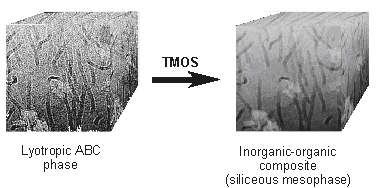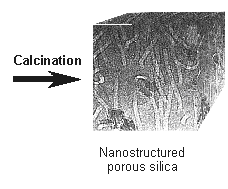

Liquid Crystal Templating
In 1992 researchers at Mobil demonstrated the synthesis of hexagonally packed mesoporous silicate and aluminosilicate materials with uniform pore sizes, evenly distributed throughout the material. These materials were termed MCM-41. Their synthesis was achieved by the use of surfactant micelles as structure directing agents in a sol-gel process. Amphiphillic surfactants self assemble into cylindrical micelles, which are encapsulated by an inorganic material (silicate or aluminosilicate in this case), which balances the charge on the micellular surfaces. Calcination, a thermal processing technique is then used to remove the organic surfactant, leaving a hexagonal arrangement of mesopores.


This process employs a liquid crystal templating mechanism, and is used to synthesise pores up to 100Å in diameter with surface areas of up to 700m²/g.
Sol-gel technology, first used in 1846 by J.Ebelman, is now commonly used in the synthesis of ceramics. It involves the formation of a solid phase, through the gelation of a colloidal suspension (sol). There are two possible routes for this process:
i)Inorganic route ; this hydrothermal technique involves the formation of a sol from a very fine powder of the silicate starting material. This is then heated and dehydrolysed to form the ceramic via a gel state.
ii)Organic route ; here the starting material has an organic component, for example TEOS (tetraethylorthosilicate) which is hydrolysed to form a gel, thus losing ethanol, and then heated to form the ceramic. This is a more expensive route but forms pure products of optical and electronic quality.
The liquid crystal templating mechanism used by Mobil in 1992 involved the dissolution of a surfactant species in the pre-hydrolysed inorganic pre-cursor. The mechanism is strongly influences by electrostatic and steric interactions between the solvent molecules, the inorganic species and the self assembled organic surfactants.